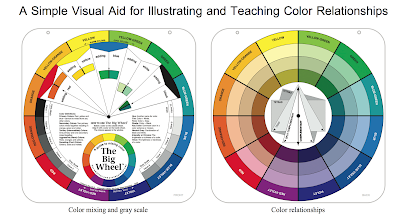References
References:
In-depth website sources:
The handprint site by Bruce MacEvoy. Everytime I begin to read this site I spend hours going from link to link, studying the descriptions of MANY historic and modern theories with an excellent analysis of the shortcomings. The site has much information on the application of color theory for painters (especially for watercolor painters, but much is true for any painter). See below for link to a useful section on mixing complements and a tour of the color wheel.
The Dimension of Color Website by David Briggs. Also full of information.
Don Finkeldei: How To Articles. Very helpful on color theory and limited palettes for oil and acrylic painters The information in these articles covers much of what we will be discussing in this first workshop:
Recommended Books and videos:
Lois Griffel: http://www.amazon.com/Painting-Impressionist-Landscape,
Margaret Kessler: Color Harmony in your Paintings.
Stephen Quiller: Color Choices: Making Color Sense out of Color Theory. I have an older book with much of the same material here, but from the new book a useful handout with suggested paints for oil, waterolor and acrylic paints.
Beth Ray: forthcoming video on Color.
Albert Handell's: http://www.amazon.com/Intuitive-Composition, http://www.amazon.com/Intuitive-Light, http://www.amazon.com/Painting-Landscape-Pastel,
Doug Higgins: http://www.amazon.com/Learn-Reilly-Teaching-Higgins-Artist, http://www.amazon.com/Prepare, and coming soon, "Landscape" by Doug Higgins, with a chapter on Color.
==================
The Principles of Harmony and the Contrast of Colors, by Michel Eugene Chevreul, This classic "color theory" text, published in 1839 as The Law of Simultaneous Color Contrast (translated into English in 1854), is an artistic milestone, one of the first systematic studies of color perception and a compendium of color design principles that many 19th century French painters from Delacroix to Matisse attempted to apply in their art (from www.handprint.com). Simultaneous contrasts, successive contrasts (after images), mixed contrasts (eye fatigue). The handprint site goes into detail about Chevreul's theories, with a mention of the out-dated parts. Handprint also suggests: Artists can benefit from repeating Chevreul's color demonstrations in order to see the color effects for themselves — a study that is more compelling than just reading the book.
In-depth website sources:
The handprint site by Bruce MacEvoy. Everytime I begin to read this site I spend hours going from link to link, studying the descriptions of MANY historic and modern theories with an excellent analysis of the shortcomings. The site has much information on the application of color theory for painters (especially for watercolor painters, but much is true for any painter). See below for link to a useful section on mixing complements and a tour of the color wheel.
The Dimension of Color Website by David Briggs. Also full of information.
Don Finkeldei: How To Articles. Very helpful on color theory and limited palettes for oil and acrylic painters The information in these articles covers much of what we will be discussing in this first workshop:
- Understanding Hue, Value and Chromatic Intensity..
- Everything You Need to Know about Color and Light.,,
- -the-simplicity-of-a-limited-palette-approach-to-painting.
- The Complete Limited Palette Color Charts.
- Mixing grays
Recommended Books and videos:
Lois Griffel: http://www.amazon.com/Painting-Impressionist-Landscape,
Margaret Kessler: Color Harmony in your Paintings.
Stephen Quiller: Color Choices: Making Color Sense out of Color Theory. I have an older book with much of the same material here, but from the new book a useful handout with suggested paints for oil, waterolor and acrylic paints.
Beth Ray: forthcoming video on Color.
Albert Handell's: http://www.amazon.com/Intuitive-Composition, http://www.amazon.com/Intuitive-Light, http://www.amazon.com/Painting-Landscape-Pastel,
Doug Higgins: http://www.amazon.com/Learn-Reilly-Teaching-Higgins-Artist, http://www.amazon.com/Prepare, and coming soon, "Landscape" by Doug Higgins, with a chapter on Color.
==================
The Principles of Harmony and the Contrast of Colors, by Michel Eugene Chevreul, This classic "color theory" text, published in 1839 as The Law of Simultaneous Color Contrast (translated into English in 1854), is an artistic milestone, one of the first systematic studies of color perception and a compendium of color design principles that many 19th century French painters from Delacroix to Matisse attempted to apply in their art (from www.handprint.com). Simultaneous contrasts, successive contrasts (after images), mixed contrasts (eye fatigue). The handprint site goes into detail about Chevreul's theories, with a mention of the out-dated parts. Handprint also suggests: Artists can benefit from repeating Chevreul's color demonstrations in order to see the color effects for themselves — a study that is more compelling than just reading the book.
=====================================
And...
http://www.tigercolor.com/color-lab/color-theory/color-theory-intro.htm. Color Lab: Color theory, tutorials & resources. (Caveat: website was constructed to promote a product, which I have not used). Good outline of color theory. It uses the Itten Color Wheel, almost identical with the color wheel produced by The Color Wheel Company. Online images are available on this tiger color site.
And...
http://www.tigercolor.com/color-lab/color-theory/color-theory-intro.htm. Color Lab: Color theory, tutorials & resources. (Caveat: website was constructed to promote a product, which I have not used). Good outline of color theory. It uses the Itten Color Wheel, almost identical with the color wheel produced by The Color Wheel Company. Online images are available on this tiger color site.
https://m.youtube.com/watch?v=mbva3cob9N4 . Short (5 minute) uTube clip with some examples from the book by Dan Bartges his book, Color is Everything, useful guide to using the Triadic Color Wheel from The Color Wheel Company.


